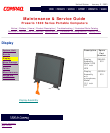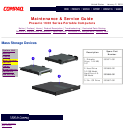
United States January 2, 2003
Maintenance & Service Guide
Presario 1600 Series Portable Computers
Notice | Preface | Home | Product Description | Troubleshooting | Illustrated Parts Catalog
Removal & Replacement Procedures | Specifications | Connector Pin Assignments | Battery Pack
Electrostatic Discharge
This chapter provides general service information for the Compaq Presario
Series of portable computers. Adherence to the procedures and precautions
described in this chapter is essential for proper service. The topics covered
include Electrostatic Discharge and its effects, a table of activities that
Generate Static and the potential voltages, ways of Preventing Electrostatic
Damage to Equipment, and Preventing Damage to the Drive, Grounding
Methods, Grounding Work Areas, and Recommended Materials and Equipment
to use in the service area. Return to
Removal & Replacement Procedures.
Electrostatic Discharge
A sudden discharge of static electricity from a finger or other conductor can
destroy static-sensitive devices or microcircuitry. Often the spark is neither
felt nor heard, but damage occurs. An electronic device exposed to
electrostatic discharge (ESD) may not be affected at all and will work
perfectly throughout a normal cycle. Or it may function normally for a while,
then degrade in the internal layers, reducing its life expectancy.
Networks built into many integrated circuits provide some protection, but in
many cases, the discharge contains enough power to alter device parameters
or melt silicon junctions.
Generating Static
The table below shows how different activities generate static electricity and
at different electrostatic voltage levels.
Typical Electrostatic Voltages
Relative Humidity
Event 10% 40% 55%
Walking across carpet 35,000 V 15,000 V 7,500 V
Walking across vinyl floor 12,000 V 5,000 V 3,000 V
Motions of bench worker 6,000 V 800 V 400 V
Removing DIPS from plastic tubes 2,000 V 700 V 400 V
Removing DIPS from vinyl trays 11,500 V 4,000 V 2,000 V
Removing DIPS from Styrofoam 14,500 V 5,000 V 3,500 V
Removing bubble pack from PCBs 26,000 V 20,000 V 7,000 V
Packing PCBs in foam-lined box 21,000 V 11,000 V 5,000 V
NOTE: 700 volts can degrade a
product.
Preventing Electrostatic Damage to Equipment
Many electronic components are sensitive to ESD. Circuitry design and
structure determine the degree of sensitivity. The following proper packaging
and grounding precautions are necessary to prevent damage:
■ To avoid hand contact, transport products in the static-safe containers such as tubes,
bags, or boxes.
■ Protect all electrostatic parts and assemblies with conductive or approved containers or
packaging.
■ Keep electrostatic sensitive parts in their containers until they arrive at static-free stations.
■ Place items on a grounded surface before removing them from their container.
■ Always be properly grounded when touching a sensitive component or assembly.
■ Place reusable electronic-sensitive parts from assemblies in protective packaging or
conductive foam.
■ Use transporters and conveyors made of anti-static belts and metal roller bushings.
Mechanized equipment used for moving materials must be wired to ground and proper
materials selected to avoid static charging. When grounding is not possible, use an ionizer
to dissipate electric charges.
Preventing Damage to Drive
To prevent static damage to hard drive and diskette drive, use the following
precautions:
■ Handle drive gently, using static-guarding techniques.
■ Store drive in the original shipping containers.
■ Avoid dropping drive from any height onto any surface.
■ Handle drive on surfaces that have at least one inch of shock-proof foam.
■ Always place drive PCB assembly side down on the foam.
Grounding Methods
The method for grounding must include a wrist strap or a foot step at a
grounded work area. When seated, wear a wrist-strap connected to a
grounded system. When standing, use footstraps and a grounded floor mat.
Static-Shielding Protection Levels
Method Voltages
Anti-static Plastic 1,500
Carbon-Loaded Plastic 7,500
Metallized Laminate 15,000
Grounding Work Areas
To prevent static damage at the work area, use the following precautions:
■ Cover the work area with approved static-dissipative material. Provide a wrist strap
connected to the work surface and properly grounded tools and equipment.
■ Use static-dissipative mats, Heel straps, or air ionizers to give added protection.
■ Handle electrostatic sensitive components, parts, and assemblies by the case or PCB
laminate. Handle them only at static-free work areas.
■ Avoid contact with pins, leads, or circuitry.
■ Turn off power and input signals before inserting and removing connectors or test
equipment.
■ Use fixtures made of static-safe materials when fixtures must directly contact dissipative
surfaces.
■ Keep work area free of nonconductive materials such as ordinary plastic assembly aids and
Styrofoam.
Use field service tools, such as cutters, screwdrivers, vacuums, that are
conductive.
Use a portable field service kit with a static dissipative vinyl pouch that folds
out of a work mat. Also use a wrist strap and a ground cord for the work
surface. Ground the cord to the chassis of the equipment undergoing test or
repair.
Grounding Equipment
Use the following equipment to prevent static electricity damage to the
equipment:
Wrist-straps are flexible straps with a minimum of 1 megohm +/- 10%
resistance to the ground cords. To provide proper ground, a strap must be
worn snug against the skin. On grounded mats without banana-plug
connectors, connect a wrist strap with alligator clips.
Heelstraps/Toestraps/Bootstraps can be used at standing work areas and are
compatible with most types of boots and shoes. On conductive floors or
dissipative floor mats, use them on both feet with a minimum of 1 megohm
resistance between operator and ground. To be effective, the conductive
strips must be worn in contact with the skin.
Recommended Materials and Equipment
Other materials and equipment that are recommended for use in preventing
static electricity include:
■ Anti-static tape
■ Anti-static smocks, aprons, or sleeve protectors
■ Conductive bins, and other assembly or soldering aids
■ Conductive foam
■ Conductive tabletop work areas with ground cord of 1 megohm of resistance
■ Static dissipative table or floor mats with hard tie to ground
■ Field service kits
■ Static awareness labels
■ Wrist-straps and footwear straps providing 1 megohm +/- 10% resistance
■ Material handling packages
■ Conductive plastic bags
■ Conductive plastic tubes
■ Conductive tote boxes
■ Metal tote boxes
■ Opaque shielding bags
■ Transparent metallized shielding bags
■ Transparent shielding tubes
Back to top
privacy statement
legal notices


















